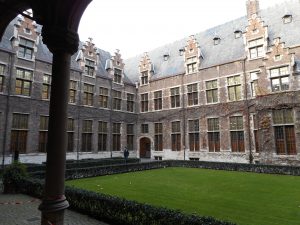Hof van Liere: a symbol of wealth
Between 1515 and 1520 Arnold van Liere, mayor of the town, had a mansion built on newly developed grounds to the east of the city. People say one of the many guests to stay with mayor van Liere was the young Charles of Habsburg. The same one who later became Emperor Charles V. That is why this mansion is still called Prinsenhof. It also explains how the Prinsstraat got its name. Another visitor to stay with van Liere was the German painter Albrecht Dürer. In his diary he wrote he had never before seen a house so beautiful, so rich. One of the architects for the complex is Domien De Waghemaekere, one of the top architects of the era.
Different functions for Hof van Liere

After van Liere’s death the city bought the complex and housed the English Nation in it. A corridor linked the complex with the wool store houses in the Venusstraat. After the Spanish Fury of 1576 many English traders decided to leave the city. By 1583 the English House stood empty.
In 1601 Albrecht and Isabella wanted to install the house as their residence. This was refused by the magistrate. They preferred to hand over the complex to the jesuits. They wanted to use it to house their college that had grown too big at Conscienceplein.
In 1713 the jesuit order was abolished. In the Austrian period the buildings were used as a military academy. The French used it to house a military hospital in it. Afterwards the building started to be neglected and got the nature of a ruin.
Re-enter the jesuits

In the first half of the 20th century the jesuits took possession of the neglected buildings. They started a series of restaurations and renovations to make the building fit for their Higher Commercial School “Sint-Ignatius”. In the ’60s this highschool was transformed in a university. UFSIA (Universitaire Faculteiten Sint-Ignatius), which later fused with the other Antwerp university center (RUCA, run by the government) to eventually form the University of Antwerp.
Nowadays Hof van Liere houses the City Campus of UA. In recent years a completely new library has successfully been incorporated the historical buildings.
The website of UA: https://www.uantwerpen.be/en/